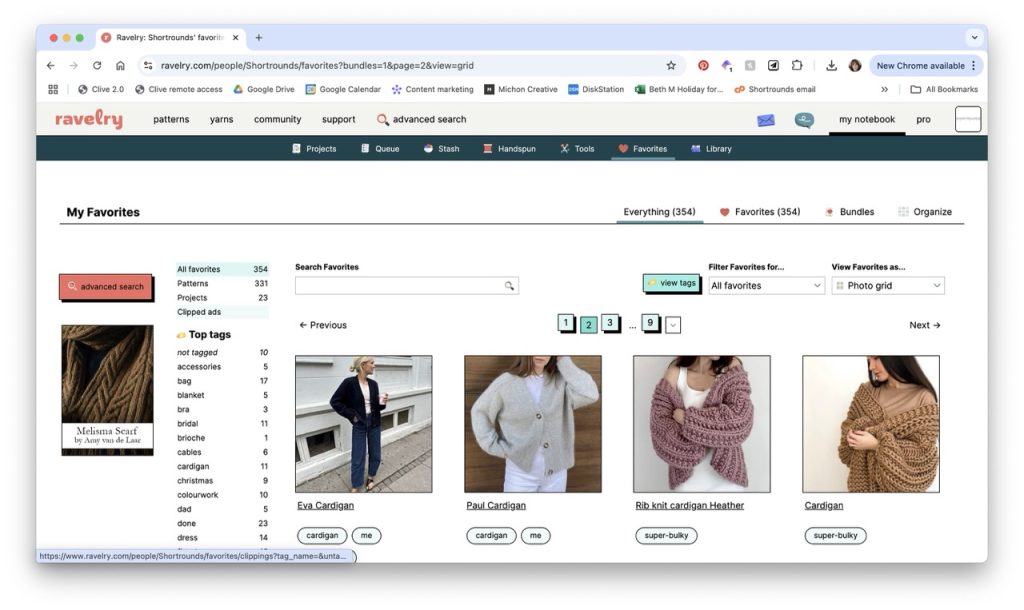Some knitters fly by the seat of their handmade shorts, casting on with nothing more than blind faith. Others build systems. Glorious, glorious systems. I’m firmly in the latter camp with my spreadsheets, Ravelry pages, sensitive skin yarn libraries and all. Because nothing curdles the joy of a new WIP quite like realising you’ve knitted this exact sleeve before. Twice. And you still didn’t write down what modifications you made. (I’ve been burned before as you can tell.)
Here’s a peek inside how I keep my projects, knitting wish list and yarn stash in working order, and why it makes my knitting life infinitely easier (and, dare I say, more satisfying).
(If you’re not explicitly Type A like me, don’t worry, I see your eye rolls and fully embrace the fact that I might have a problem. Do read on, I’m making myself available for lighthearted mockery and side eyes…)
Why I started tracking my knits
Firstly, before I say anything else, having a system to track your knitting projects is a game-changer. Once upon a time, I thought I could remember everything: which knitting pattern I used, how I modified the sleeves, what needle size gave me gauge perfection. But now I’ve been knitting consistently for over 15 years, it’s impossible to recall every detail on everything I’ve ever made.
Now, I track every knit. Not just for my own peace of mind, but for motivation, fit consistency and yes, so I can smugly reply when someone asks, “What yarn is that?” without having to dig through a mystery bag of yarn labels. (I actually recently threw out all my old yarn labels that were taking up so much space in my stash cupboard, thanks to the very system I’m just about to talk about.)
My knitting project tracker system
Over the years I’ve not found one tool to rule them all. I use a blend that’s evolved over time and keeps my knitting workflow calm and clear (and maybe a little bit colour-coded).
1. Ravelry project tracking + pattern wishlist

Ravelry is my go-to for tracking specific projects but only once I’ve cast on. It’s where I keep track of the pattern, yarn, gauge, needle size and any modifications in detail. I’m rubbish at uploading photos after I’ve finished, but I keep telling myself I’ll get around to it. I’m working on it.
Ravelry is also where I keep tabs on my favourites. I bookmark patterns that catch my eye, and tag them by occasion, who it’s for or a technique I want to try. It’s like window shopping, but with yarn.
Once I officially cast on a project, it gets a shiny new Ravelry project page. I like to think of it as my digital knitting diary.
Come and say ‘Hi’! Visit my profile page on Ravelry and add me as a friend to follow my progress.
2. The Spreadsheet: knitting project planning + gift tracking
Before a project goes on the needles, it lives in my knitting project planner spreadsheet, or ‘Wish knits’. The true brain of my system. If I’ve seen a pattern I like I tend to add it to my favourites in Ravelry, but I’ve never really got along with the queue system in Ravelry itself. So when I’m actually considering making something and need to start planning for it, in my Wish Knits spreadsheet I track:
- Where the pattern’s from
- The colour I’m after
- Who I’m knitting for
- What occasion it’s for
- What yarn I could use (bonus points for stash busting!)
- Cost of yarn if buying
- When I hope to cast on (aspirational, let’s be honest)
This spreadsheet is especially helpful for planning gift knitting ahead of birthdays, Christmas or baby showers. Once I cast on, it graduates to Ravelry with its own dedicated project page. But until then, it lives in spreadsheet purgatory (where dreams and deadlines live side by side).
3. Yarn library: my stash + sensitive fibre tracking
Yes, I have two yarn libraries. No, I’m not sorry.
- Used yarn library – here I track the brand, fibre content, yarn weight, colourway, dye lot, what project I used it for and any notes for “future me” to consider. It’s ideal for matching yarns to future patterns, recalling what I used at a glance and stash planning.
- Sensitive yarn library – I have very reactive skin. Even so-called “soft yarn” can make me itch. So I keep a list of yarns people recommend (thank you Helle from Danish Musings who regularly speaks on her podcast about having sensitive skin and makes the best recommendations), test them one skein at a time and only add them to the “safe” list once they’ve passed the wear test. I’ve found this list to be indispensable to me when project planning, and it helps to keep me away from potentially scratchy yarn!
What I track (without getting overwhelmed)
That might sound like a lot to you…it might not. But it works really well for me right now, and it’s a process that’s been evolving over time. Even if you’re not spreadsheet-inclined, here’s what I’d recommend tracking for each knit:
- Yarn details (brand, fibre, weight, colourway)
- Needle size and type (metal vs bamboo can affect your knitting tension)
- Gauge before and after blocking
- Pattern source and any modifications
- Start and finish dates (for posterity, not guilt)
- Fit and wear notes, especially after a few washes
Why you should track knitting projects
Keeping track of your knitting really helps, regardless of whether you knit socks, jumpers, shawls or soft toys. The main reasons I’ve found it useful are it:
- Prevents mistakes and I can repeat modifications that worked
- Matches my stash to patterns more easily
- Helps avoid skin reactions if you’re sensitive to fibre
- Keeps me motivated and accountable (especially with long-term WIPs)
- Helps check back on what yarn and how much I used in old projects
- Means I can celebrate how far I’ve come in my knitting
You don’t need to do it my way. But find a way. You’ll thank yourself the next time you reach for a pattern you haven’t touched since 2021 and want to recreate the exact magic (I’m thinking of my perfect Stockholm Sweater as I write this).
Ready to get started?
Have you got your own system? I love a peek inside someone else’s WIP drawer, so share your knitting organisation tips or tag me on Instagram!
Beth x

